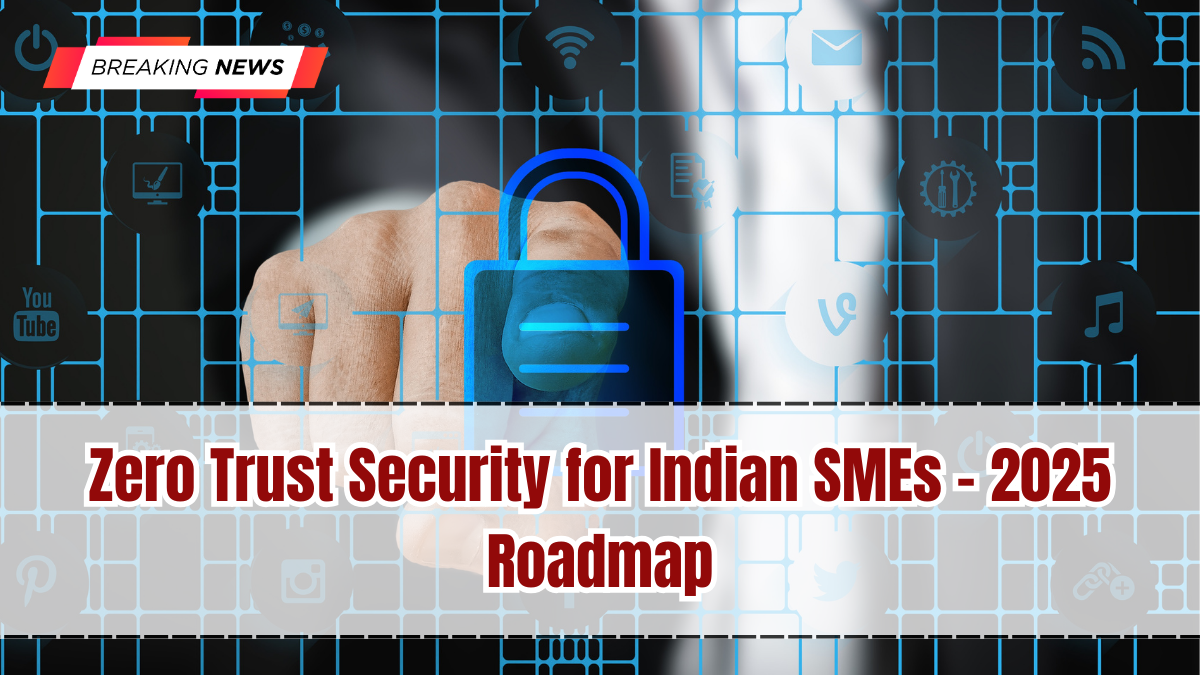Cybersecurity threats are evolving at a rapid pace, and businesses can no longer rely on traditional security measures. In 2025, Indian Small and Medium Enterprises (SMEs) are under increasing pressure to protect sensitive data and ensure compliance with global standards. The Zero Trust Security India 2025 roadmap highlights a modern approach to tackling cyber risks—one that assumes no user or device can be trusted automatically, whether inside or outside the network.
For SMEs, adopting Zero Trust is no longer optional. With rising cases of ransomware, phishing, and insider threats, this model provides a proactive framework to strengthen defenses and build customer trust.

What is Zero Trust Security?
The Zero Trust model operates on the principle of “never trust, always verify.” Unlike traditional security systems that rely on firewalls and perimeter defenses, Zero Trust requires continuous verification of all users, devices, and applications before granting access.
The Zero Trust Security India 2025 approach ensures that data, systems, and applications remain protected even if one layer of security is compromised. This makes it a critical tool for Indian SMEs handling sensitive customer data, financial records, and intellectual property.
Why SMEs Need Zero Trust in 2025
Indian SMEs face unique challenges when it comes to cybersecurity:
-
Limited Budgets: Many small businesses cannot afford large-scale security teams.
-
Remote Work Trends: Increased work-from-home practices expose systems to external risks.
-
Cloud Adoption: With more SMEs moving to cloud-based platforms, traditional firewalls are insufficient.
-
Compliance Needs: SMEs serving global clients must comply with standards like GDPR and India’s Digital Data Protection Act 2023.
The Zero Trust Security India 2025 roadmap provides SMEs with scalable, cost-effective solutions to tackle these challenges.
Core Components of Zero Trust
To implement the Zero Trust Security India 2025 model, SMEs need to focus on several components:
-
Identity Verification: Multi-factor authentication (MFA) ensures only verified users gain access.
-
Device Security: Monitoring and controlling devices that connect to the network.
-
Least Privilege Access: Users only get access to the specific resources they need.
-
Micro-Segmentation: Dividing the network into smaller sections to contain breaches.
-
Continuous Monitoring: Real-time analytics to detect unusual behavior and respond quickly.
These components ensure a layered and adaptable defense system for SMEs.
Steps for SMEs to Adopt Zero Trust
The Zero Trust Security India 2025 roadmap outlines practical steps SMEs can take:
-
Assess Current Infrastructure: Identify existing vulnerabilities and gaps.
-
Implement MFA: Secure user logins across devices and applications.
-
Secure Cloud Applications: Use identity-based access control for SaaS platforms.
-
Network Segmentation: Divide internal networks to reduce exposure to breaches.
-
Adopt Endpoint Security: Monitor all devices accessing the system, including employee mobiles.
-
Leverage AI Tools: Use AI-driven threat detection for faster response.
-
Employee Training: Educate staff on phishing and cybersecurity best practices.
These steps allow SMEs to adopt Zero Trust gradually without overwhelming costs.
Benefits for SMEs
Adopting the Zero Trust Security India 2025 model brings multiple benefits:
-
Enhanced protection against ransomware and data breaches.
-
Improved compliance with global and Indian data protection laws.
-
Reduced insider threat risks through access restrictions.
-
Increased customer trust and brand credibility.
-
Cost savings from avoiding expensive security breaches.
For SMEs looking to grow and expand globally, these benefits are invaluable.
Challenges in Implementation
While the Zero Trust Security India 2025 roadmap is promising, SMEs may face hurdles:
-
Limited technical expertise to manage advanced systems.
-
Initial investment in tools and training.
-
Resistance from employees due to stricter access controls.
To address these, many SMEs are partnering with managed security service providers (MSSPs) who offer affordable, outsourced cybersecurity solutions.
Future of Zero Trust in India
The Zero Trust Security India 2025 adoption rate is expected to grow rapidly, with government initiatives encouraging cybersecurity compliance for businesses of all sizes. With digital transactions, cloud storage, and AI adoption increasing, Zero Trust will become the default security model for Indian enterprises. SMEs embracing this model today will not only safeguard their data but also gain a competitive edge in winning customer trust.
Conclusion
The Zero Trust Security India 2025 roadmap is clear: Indian SMEs must shift from outdated perimeter-based security to a model that constantly verifies and monitors access. By adopting Zero Trust, businesses can reduce risks, improve compliance, and protect sensitive data in an increasingly digital world. While challenges exist, the long-term benefits far outweigh the costs. For SMEs, the time to embrace Zero Trust is now.
FAQs
What is Zero Trust Security?
It is a cybersecurity model that assumes no user or device can be trusted automatically and requires continuous verification.
Why is Zero Trust important for SMEs?
It protects small businesses from cyber threats, ensures compliance, and boosts customer trust.
Does Zero Trust require expensive technology?
No, SMEs can adopt it gradually with affordable tools like MFA, endpoint security, and cloud access controls.
How does Zero Trust improve compliance?
It aligns with global and Indian data protection laws by securing access and monitoring data usage.
Can SMEs outsource Zero Trust implementation?
Yes, many SMEs work with managed security providers for cost-effective implementation.
Click here to know more.
